A History of the County of Northampton: Volume 4. Originally published by Victoria County History, London, 1937.
This free content was digitised by double rekeying. All rights reserved.
'Parishes: Milton Malzor', in A History of the County of Northampton: Volume 4, ed. L F Salzman (London, 1937), British History Online https://www.british-history.ac.uk/vch/northants/vol4/pp271-276 [accessed 2 May 2025].
'Parishes: Milton Malzor', in A History of the County of Northampton: Volume 4. Edited by L F Salzman (London, 1937), British History Online, accessed May 2, 2025, https://www.british-history.ac.uk/vch/northants/vol4/pp271-276.
"Parishes: Milton Malzor". A History of the County of Northampton: Volume 4. Ed. L F Salzman (London, 1937), British History Online. Web. 2 May 2025. https://www.british-history.ac.uk/vch/northants/vol4/pp271-276.
In this section
MILTON MALZOR
Midleton (xi cent.); Middleton Malsores (xiv cent.); Milton alias Middleton Malsor (xviii cent.).
The parish of Milton Malzor covers an area of 1,479 acres. The subsoil is of clay and sand, while the soil varies in different parts of the parish. Towards the south-east and south-west it is of a light red sandy nature, at the extremity of the south it is strong, deep, and rich, the north side is loamy. The parish is well timbered with elm and ash, and a part of it is devoted to pasture. The chief crops produced are wheat and barley. The Northampton Canal, connecting the River Nene with the Grand Junction Canal, borders the north-west part of the parish.
Many 17th- and early-18thcentury stone cottages with highpitched thatched roofs and coped gable ends remain in the village, though in most cases the windows have been modernized. One of these houses, in the middle of the village, bears a tablet inscribed '1638, S.M., I.M.'; another near the north end has '1654, a.p., t.p.', and a third is dated 1701.
Of the two manor-houses that of the manor of Peverel, known simply as The Manor, (fn. 1) is a gabled building with mullioned windows, probably of early-16thcentury date, with a two-story bay window on its west side, but the east front was rebuilt in the 18th century. To the northwest of the house is a rectangular stone dovecote with tiled roof, one of the gables of which has been rebuilt in brick. The other manor-house (Mantell's) is on the west side of the village and is now known as Milton Manor. Its south front, facing the road, was rebuilt in the 18th century and is a simple stuccoed composition of two stories, with cornice, sash windows, and pedimented doorway. (fn. 2) The older part of the house contains a good 17th-century oak staircase. (fn. 3) 'Milton House', which stands a little to the west of the Manor, was enlarged in 1777 by the addition of a south wing faced with Duston stone. (fn. 4) The house known as 'Mortimers', on the south side of the village, is a long, plain two-story building of 18th-century date.
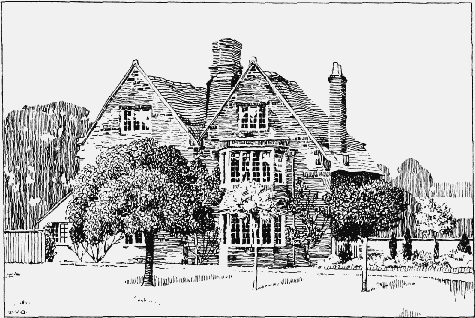
Bardolf. Azure three cinq foils or.
Manors
In 1086 William held of Geoffrey Alselin 3½ hides in MILTON. To the manor pertained 2 hides less a virgate in Collingtree which were let to two socmen, and ½ hide in Rothersthorpe. (fn. 5) At the time of the Northamptonshire Survey (12th cent.) these 5¼ hides in Milton and Collingtree were held by Robert de Causho and Geoffrey. (fn. 6) The lands of Geoffrey Alselin descended to Ralph Hauselyn who died without male heirs, leaving his property to Thomas Bardolf, husband of his grand-daughter Rose. (fn. 7) William son of Doun son of Thomas Bardolf held the overlordship of 1 knight's fee in Milton and Collingtree of the honor of Peverel, about 1236. (fn. 8) He survived until late in 1275, (fn. 9) being succeeded by his son William, who held the overlordship in 1284, (fn. 10) which passed on his death in 1290 (fn. 11) to his son Hugh, who died in 1304, (fn. 12) and from him to his son Thomas. He died in 1330, (fn. 13) leaving 1 knight's fee in Milton to his wife Agnes who held it until her death on 12 December 1357. (fn. 14) Her son John, who was 30 years old at the time of her death, died before October 1361 when his son William was a ward of the king. (fn. 15) William died before 1389–90 seised of ¾ of a knight's fee in Milton and Collingtree, which was probably forfeited with his other property when his son Thomas was convicted of treason. (fn. 16)
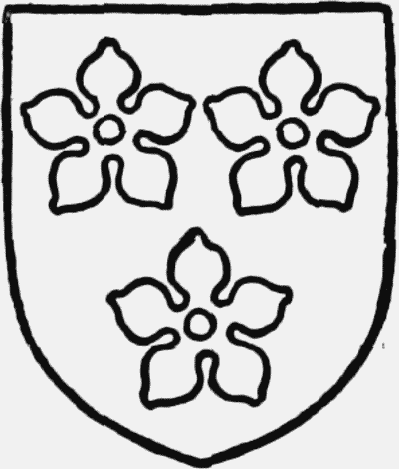
Milton Malzor: The Manor
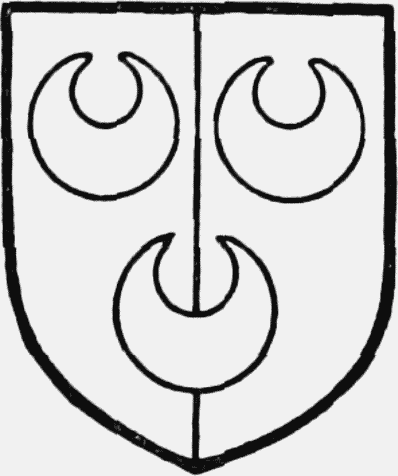
Malesoures. Party azure and gules three crescents argent.
The family of Malesoures from which Milton took its distinctive name was settled there from an early date, the first recorded member being William Malesoures who sued Richard son of Reynold in 1208 for a virgate of land in Collingtree, first in the court of Doun Bardolf and later in the king's court. (fn. 17) John Malesoures held a knight's fee in Milton and Collingtree of William Bardolf in 1235 and 1242. (fn. 18) The fee descended to William Malesoures who held it in 1284, (fn. 19) from whom it passed to his son William and the latter's son John Malesoures, who had possession of it in 1316 (fn. 20) and was succeeded by his son Ralph. (fn. 21) Thomas son of Ralph Malesoures died in October 1361 seised of the manor, which he held jointly with his brother Hugh who survived him, with remainder to his daughter Amice, then aged nine, and Hugh's heirs. (fn. 22) Amice married Sir Roger Parwick, (fn. 23) who was involved in 1387 in a lawsuit over the presentation to the churches of Milton and Collingtree. (fn. 24) In 1412 William Parwick held land in the two parishes to the value of £22, (fn. 25) and in 1428 the heirs of John Parwick were in possession of the lands formerly held there by Thomas Josep and Philip Malesoures. (fn. 26)
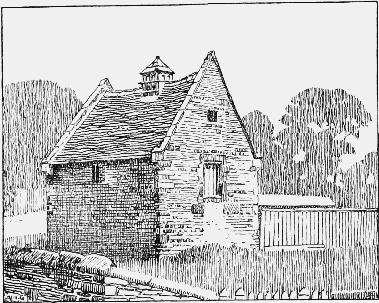
Milton Malzor: Dovecote
In 1481 the manor of Milton and Collingtree was held by Richard Parwick who on 20 June of that year settled it on his son William and Godith his wife. They settled the manor on their daughter Rose, wife of William Digby, in 1506, but she died before her mother, on whose death in 1518 it passed to Rose's son John Digby then a minor of eleven years. (fn. 27) John married Mary daughter of William, Lord Parr, by whom he had one son William Digby. Mary survived her husband and then married Henry Brook, to whom William sold the manor in December 1552. Their son Roger Brook married Mary daughter of Sir Thomas Fullchurch and died on 22 November 1558, leaving a young daughter Mary (fn. 28) who died in June 1564. The manor descended under her grandfather's will to Basil Brook, son of his nephew Andrew. (fn. 29) He conveyed it to William Goodere in 1581, (fn. 30) from whom it passed to Sir William Samwell of Upton in 1595. (fn. 31) He settled the manor on his daughter Jane on her marriage with Sir Sapcotes Harrington of Rand, who sold it to Francis Harvey, serjeant-at-law, in 1621. (fn. 32) On the marriage of his son Stephen with Mary Murden he settled the manor on him. Stephen predeceased his father in March 1630 leaving a son Francis aged 7 years. (fn. 33) Francis died in September 1643, his heir being his brother Richard who was then nineteen. (fn. 34) From Richard Harvey the manor passed to Richard Gleed and his son Edmund, who survived him and bequeathed it to his son Richard by his will of 25 April 1679. By 1720 Elizabeth the only daughter of Richard Gleed and widow of Richard Dodwellwas lady of the manor. (fn. 35) At the time of the inclosure John Darker held the manor, which passed on his death in February 1784 (fn. 36) to his grand-daughter, Mary Nash, who married William Blake of Danesbury, near Welwyn. The manor remained in the possession of the family until the latter part of the 19th century when Col. A. Blake sold it to Mr. James Asplin, who remained lord of the manor until his death in 1923.
The heirs of Robert de Causho kept the overlordship of his lands in Milton and Collingtree, as of the fee of Cauz, until 1235, (fn. 37) but by 1242 it had passed to Robert de Everingham who held of the honor of Lexington. (fn. 38) In 1284 Philip de Quenton held a mesne lordship of one fee of Robert de Everingham, (fn. 39) which he conveyed to Philip de Gayton by fine in 1292–3. (fn. 40) Philip died without issue in 1316, (fn. 41) being succeeded by his brother Theobald who died childless a few days after him, (fn. 42) his heirs being his two sisters, Juliana, who was later burnt for the murder of her husband, Thomas Murdak, (fn. 43) and Scholastica widow of Geoffrey de Meaux. Theobald's wife held a third of his lands in Milton and Collingtree in dower, (fn. 44) but by 1322 Scholastica had possession of the whole of the knight's fee formerly held by her brothers. (fn. 45) She died in 1354, her son John, then aged 40 years, succeeding her. (fn. 46) Sir John de Meaux died without heirs some time after 1377, (fn. 47) and the fee evidently passed with the manor of Gayton to the Trussell family. The last mention of the overlordship occurs in 1504 when William Tanfeld of Gayton is named as the overlord. (fn. 48)
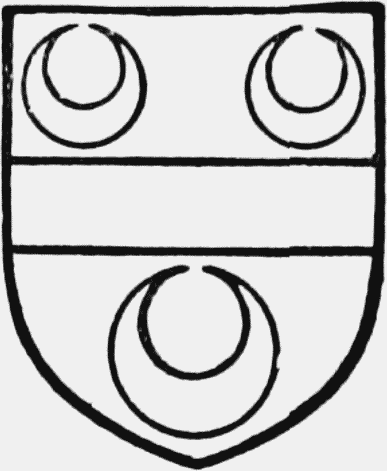
Pateshull. Argent a fesse sable between three crescents gules.
At the end of the 12th century William de le Fremont owned land in Milton and Collingtree which he conveyed to Simon de Pateshull together with half the advowson of the churches of Milton and Collingtree in 1201. (fn. 49) William died without issue and his lands here were divided among his sisters, one of whom, Emma, wife of William de Gatesbury, conveyed her sixth share to William de Pateshull in 1224. (fn. 50) Hugh de Pateshull, Bishop of Coventry and Lichfield and younger son of Simon, held 1½ fees in Milton and Collingtree in 1235–6 of the fee of Cauz, (fn. 51) which his nephew Simon, son of his elder brother Walter, held in 1242–3 of Robert de Everingham. (fn. 52) He was succeeded by his son John who held a fee of Philip de Quenton in 1284. (fn. 53) From him the manor passed to his son Simon who died in 1295 holding the manor of Philip de Gayton by service of a knight's fee and a rent of £10. (fn. 54) His son John, who was only four years old at the time of his father's death, was returned as one of the tenants of Milton and Collingtree in 1316, (fn. 55) and died in 1349 holding the land of Scholastica de Meaux by service of 22s. yearly. It was rented at £27 8s. 3½d. and rents of 4 capons, 6 hens, and 6 horseshoes with nails from divers tenements arrented of old. (fn. 56) His son William died without issue ten years later and, on the division of his property among his four sisters, (fn. 57) the 2 virgates in Milton and Collingtree were assigned to Alice, the wife of Thomas Wake of Blisworth. (fn. 58) On her death in 1398 (fn. 59) she was succeeded by her grandson Thomas, whose son Thomas held ½ fee in Milton and Collingtree in 1428. (fn. 60) He died on 10 September 1458 holding the manor jointly with his wife Agnes, his heir being his son Thomas who was born about 1434. (fn. 61) Roger Wake succeeded his father on his death in May 1476. (fn. 62) He was attainted as a follower of Richard III in 1485, his manor of Milton and Collingtree being granted to Sir Charles de Somerset, (fn. 63) but he subsequently obtained a pardon and restitution of his lands. (fn. 64) By deed of 10 March 1496 he conveyed the manor to feoffees appointed as executors of his will. He died on 16 March 1504, leaving to his brother William an annual rent of £15 from the manors, and land worth £12 yearly there to be amortized to the use of the chaplain of the chantry he founded at Blisworth. (fn. 65) His heir Thomas Wake subsequently sold the manors to Oliver Wood, who by his will of 21 May 1520 left them to his daughter Margaret, wife of Sir Walter Mantell, with remainder to their sons John, Walter, and Thomas in tail male. (fn. 66) From this ill-starred family the manors became known as MANTELL'S MANOR.
The eldest son of John Mantell was convicted of felony and put to death, leaving a son Walter who later suffered the same fate on being convicted of treason. Walter Mantell, the second son, was also attainted on a charge of treason, and on the death of Margaret, then the widow of Sir James Hales, in 1567, the manor passed to Walter's eldest son Matthew who was aged 21 years. (fn. 67) The property was at this time described as the manors of Milton next Collingtree, Milton Malzor, and Collingtree. Matthew Mantell conveyed the manors to Francis Foxley in 1589, (fn. 68) from whom they passed to William Dry in 1610. (fn. 69) He died in 1637, being buried in Milton Malzor Church, where an inscription describes him as 'Yeoman, Lord of a Manor in this towne called Mantell's-Manor'. (fn. 70) He was succeeded by his son William who was living in 1666, (fn. 71) but had been succeeded in 1686 by his son Edward Dry, (fn. 72) who died on 19 November 1707. (fn. 73) By the marriage of Anne daughter of Edward Dry, the manor came to Edward Price, who presented to the church of Milton Malzor in 1745. (fn. 74) At the time of the inclosure in 1779 James King was the lord of the manor, but he sold it soon after to Joseph Dent, whose descendant, Sir W. Ryland Dent Adkins, K.C., held it till his death in 1925.
Church
The church of THE HOLY CROSS (fn. 75) consists of chancel 30 ft. 6 in. by 15 ft. 4 in. with north and south chapels each 18 ft. 6 in. by 16 ft. 6 in., clerestoried nave 42 ft. 3 in. by 18 ft. 9 in., north and south aisles 14 ft. 6 in. wide, south porch, and west tower 7 ft. 6 in. by 8 ft. 6 in., all these measurements being internal. The width across nave and aisles is 53 ft. The chapels are continuous eastward of the aisles and cover the chancel for more than half its length.
The building generally is of roughly coursed limestone, with straight parapets to the chancel, nave, and aisles. The roofs are all modern, those of the chancel, (fn. 76) nave and porch slated, the aisles leaded. All the walls are plastered internally, and the floors, except in the sanctuary, flagged. A gallery, since removed, was erected at the west end of the nave in 1817, and in 1824 the church was completely reseated. (fn. 77) The chancel was restored in 1874, and the remainder of the fabric in 1876–7, (fn. 78) when it was again reseated, the wall of the north aisle heightened, and the porch rebuilt. In 1904 St. Katharine's chapel, at the east end of the south aisle, was restored to its original purpose.
The building underwent a very considerable reconstruction in the 14th century, but the oldest parts of the present structure are the cylindrical pillars of the north arcade, which are c. 1180–90 and have circular moulded bases on square chamfered plinths, but they have been heightened and the capitals are later. The arcade is of four bays with half-round responds, but the bases of the responds are chamfered and their plinths are half-octagons. The base mouldings of the pillars (fn. 79) indicate a late-r 2th-century aisled church of some importance, no other architectural features of which have survived. That a rebuilding of the aisles took place at a fairly early date is suggested by the pointed threelight windows in their west walls, which are of three sharply pointed uncusped lights, of c. 1270. The tower is without buttresses and has so few architectural features in its lower stage that it is difficult to date. Its plinth, however, is continuous with that of the aisles and the pointed west doorway is of three continuous chamfered orders. The round relieving arch above it is too high and too wide to have been the arch of an earlier doorway, and nothing indicates that the doorway is an insertion. The great width of the aisles would suggest their having been rebuilt during the 14th-century reconstruction, when perhaps they were extended eastward to provide chapels, the old masonry being re-used and the west windows retained. The changes in the building during the 14th century included the rebuilding of the south arcade, the heightening of the north arcade, the erection of the present chancel, and of the upper part of the tower. The octagonal lantern, which is so conspicuous a feature of the church, was probably a 15th-century addition.
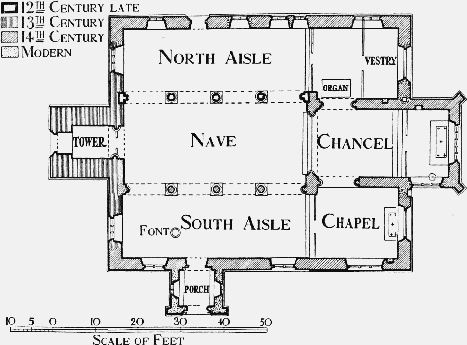
Plan of Milton Malzor Church
The chancel has diagonal angle buttresses and a chamfered plinth along the east wall. The pointed east window is of five trefoiled lights (fn. 80) with reticulated tracery and hood-mould, and there is a modern threelight window of the same character at the east end of the south wall. (fn. 81) The piscina has a round-headed trefoiled arch and plain circular projecting bowl, but it is much restored. In the north wall is a pointed aumbry, with wide chamfer, fitted with a modern door. There are no sedilia. At its west end the chancel opens on each side to the chapels, by pointed arches of two chamfered orders, the inner order on half-round responds with moulded capitals and chamfered bases; the arch to the nave is similar. These arches are without hoodmoulds and the capitals are half-octagonal. There are no screens. The floor of the chancel was raised a step in 1874, (fn. 82) and three small quatrefoil clerestory windows were introduced on each side when the new roof was erected. The reredos and oak panelling date from 1930.
The south chapel (St. Katharine's) is lighted from the east by a large and beautiful 14th-century traceried wheel window set within a plain deeply recessed opening (fn. 83) high in the wall. (fn. 84) A copy of this window, which is the outstanding architectural feature of the church, was inserted in the north chapel in 1856, in the place of a then existing window of two lights, but the authority for such 'restoration' is doubtful. (fn. 85) There are piscinas in both chapels; that in the north chapel has a plain trefoiled chamfered head and circular bowl, but the larger one in St. Katharine's chapel has a pointed arch with cinquefoil cusping, hollow-chamfered jambs and fluted bowl. (fn. 86) At the north end of the east wall of the south chapel is a narrow priest's doorway, now blocked, and the chapel is lighted on the south by a pointed window of three tall cinquefoiled lights. The corresponding window in the north chapel is of three trefoiled lights with good 14th-century quatrefoil tracery. The floors of the chapels are two steps above the aisles, but there are no dividing arches (fn. 87) and the roofs are continuous.
The south arcade of the nave consists of four pointed arches of two chamfered orders springing from circular pillars and half-round responds, with moulded capitals like those of the chancel arch. The bases of the responds also correspond with those in the chancel, but the bases of the pillars are moulded and on square plinths. (fn. 88) The arches are without hood-moulds. In the north arcade the older pillars, as already stated, were heightened in the 14th-century reconstruction, new capitals introduced and pointed arches like those opposite built upon them. (fn. 89)
The pointed south doorway is of two continuous chamfered orders with hood-mould, and the north doorway is also of two continuous orders, the outer moulded and the inner with a hollow chamfer. In the south aisle there is a pointed 14th-century window of two trefoiled lights and quatrefoil in the head on each side of the doorway, and the north aisle is lighted by three square-headed windows of two trefoiled lights in the north wall. (fn. 90) The west windows of the aisles have already been noted. In the north wall of the north aisle, short of the chapel, is a pointed window of two trefoiled lights, the sill of which is carried down, possibly to serve as a low-side window. (fn. 91)
The four clerestory windows date from 1877. They occur only on the south side and are small trefoil openings in triangular frames. (fn. 92)
The tower is of three stages marked externally by strings, the two lower stages having a slight batter. The west doorway has already been described. In the middle stage there is a single-light pointed window on each side, and the tall pointed bell-chamber windows are of two trefoiled lights with quatrefoil in the head. The tower terminates in a battlemented parapet with angle pinnacles. There is no vice. The pointed tower arch is of three chamfered orders, the two outer dying into the wall, the inner on half-round responds with capitals and bases like those of the responds of the nave arcades. The octagon has a window in each of its cardinal faces; on the east side a single trefoiled opening, on the south and west a pointed window of two trefoiled lights with quatrefoil in the head, and on the north a four-centred single-light moulded window. The short spire has crocketed angles and openings on four sides.
The font is apparently of late-12th-century date and consists of a plain circular curved bowl, slightly chamfered round the top, on a short modern stem and base. (fn. 93)
The pulpit dates from 1874, (fn. 94) and all the fittings are modern. An organ was first introduced in 1852. (fn. 95)
In the chancel and south chapel are marble wall monuments to Jane, wife of Sir Sapcotes Harrington and daughter of Sir William Samwell, who died in 1619, and to Richard Dodwell (d. 1726). In the north chapel is a tablet to William Dry, yeoman (d. 1637). There is a memorial in the north aisle to thirteen men of the parish killed or missing in the war of 1914–19.
There is a ring of five bells by Henry Bagley II of Chacombe 1686. (fn. 96)
The silver plate consists of a cup of 1570, a paten of 1700, and a flagon of 1772; there is also a plated alms dish. (fn. 97)
The registers before 1812 are as follows: (i) all entries 1558–1742; (ii) 1742–85; (iii) baptisms and burials 1786–1813 on parchment; (iv) baptisms September 1785–December 1795 on paper; (v) marriages 1754–1812. (fn. 98)
The churchyard was extended to the north-east in 1912 by the inclusion of a square piece of land known as the 'Hempland'. (fn. 99)
Advowson
From an early date the churches of Milton and Collingtree were united, presentations being made to the moieties of the two churches. Simon de Pateshull obtained the advowson of one moiety by the gift of William de le Fremont in 1201, (fn. 100) and his grandson held both moieties by the middle of the century. (fn. 101) At the death of Sir William de Pateshull in 1359, one moiety went to his sister Alice Wake, (fn. 102) and the other to Thomas Fauconberg, son of his sister Maud, then deceased. In 1386 he forfeited his property as an adherent of the King of France. (fn. 103) Sir Roger Parwick claimed the advowson but was defeated. (fn. 104)
During the year 1441 the last presentation to a moiety of the two churches appears to have been made. (fn. 105) They were subsequently separated and Thomas Wake died in 1459 seised of the advowson of Collingtree. (fn. 106) It seems probable that the Parwick family did eventually regain the advowson of Milton Malzor church, for in 1552 William Digby sold it with the manor to Henry Brook. The advowson followed the same descent as the manor until sold by Francis Harvey in 1659 to Sir John Potts and others. (fn. 107) It subsequently changed hands several times, and in 1925 the legatees of Mr. Pickering Phipps of Collingtree gave it to the Bishop of Peterborough.
The Baptists and Methodists have chapels in the village.
Charities
Mark Bailey by will proved 11 May 1888 gave to the vicar and churchwardens £10 to be invested and the proceeds to be given away in bread to the needy and necessitous poor. The endowment is now represented by £9 5s. 11d. Consols producing 4s. 8d. yearly in dividend which is distributed in kind to the poor.
Richard Dodwell by will proved 1 July 1726 charged certain premises in Milton with a yearly rent-charge of £2 12s. to be distributed in loaves among the poor. The rent-charge has been redeemed and the endowment is represented by £104 Consols. Under a Scheme of the Charity Commissioners dated 4 February 1898 a body of 4 trustees was appointed. The Scheme provides for the income to be distributed in kind to the deserving and necessitous poor of the parish.
Poor Estate. The endowment of this charity of which the origin is unknown consists of 2 cottages and 1 acre of land. The land and cottages are let and the rent amounting to £10 5s. annually is distributed by 3 trustees to the poor in loaves of bread.
Church or Town Estate. This charity comprises an allotment of about 19 acres of land and 4 cottages. The land and cottages are let and the rent is received by the churchwardens and applied towards church expenses.
William Underwood in about 1799 bequeathed £100 for providing bread for the poor. The endowment now consists of £184 5s. 10d. Consols producing an income of £4. 12s. 4d. which is distributed by 3 trustees to the poor in loaves of bread.
Miss Frances Montgomery by will proved 25 September 1888 gave £50 to the rector to be applied annually in the purchase of coal to be distributed amongst the poor inhabitants; the income amounts to £1 5s. 8d.